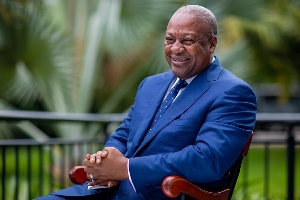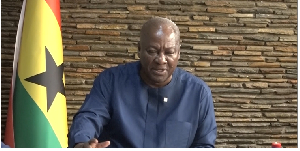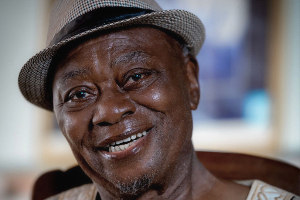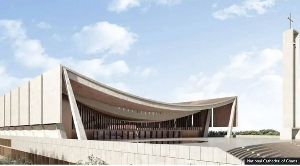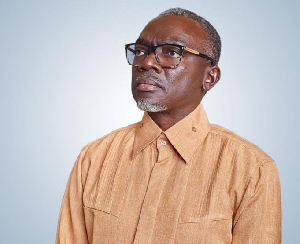In the intricate tapestry of Ghanaian politics in the fourth republic, few figures stand out as prominently as John Dramani Mahama. His tenure as president, which spans from 2012 to 2016, was marked by significant strides in national development across various sectors.
Ghana's economy is diverse, with several key sectors that are critical to its growth and development, highlighting the complexities of governance in a rapidly developing economy. Despite these complexities, President Mahama initiated bold and economic expansionary policies to deal with the challenges his government inherited and help set his long-term development goals.
His presidential tenure and leadership had a profound impact on every corner of our country, which transformed sectors such as infrastructure, education, healthcare, industry, and agriculture, leaving a lasting legacy on the nation's development trajectory.
As he gears up to contest the December 2024 presidential elections under the banner of the National Democratic Congress (NDC), it is worth revisiting some of the accomplishments and leadership that define his enduring legacy and underscore his candidacy for a pivotal return to office dubbed “Ghana’s
Second Independence”. Expansive Infrastructural Development John Mahama's presidency was marked by a significant focus on infrastructural development, reflecting his bold and clear vision to modernize the nation’s physical landscape and stimulate economic growth.
Below are some of the key areas of infrastructural development where he chalked success and demonstrated commitment to economic expansion:
Transport Infrastructure:
President Mahama's administration placed significant emphasis on improving transport infrastructure across various modes of transportation—road, air, sea, and rail. In this regard, his policies and efforts were directed at enhancing economic growth; improving connectivity; and boosting Ghana's position as
a regional hub. His leadership impact in the area of transport infrastructure can be traced across the country. Some of these projects are:
Road Infrastructure:
Eastern Corridor Road: This was one of the major road projects aimed at improving transportation links between the northern and southern parts of Ghana. The Eastern Corridor Road passes through several regions and serves as a critical route for economic activities, especially in the agricultural and mining sectors.
Kwame Nkrumah Interchange: Formerly known as the Circle Interchange, this project in Accra was designed to ease significant traffic congestion in one of the busiest parts of the city. The interchange provided a multi-tier traffic solution, incorporating flyovers and improved road links.
George Walker Bush Highway (N1 Highway): Although initiated before Mahama's presidency, significant enhancements and maintenance continued under his administration. This highway improved connectivity between Accra and several western suburbs, easing daily traffic and improving business logistics.
Ghana Urban Transport Project: While this encompasses multiple elements, a significant part was dedicated to improving road infrastructure in urban areas, including the expansion of roads and enhancement of traffic management systems in cities like Accra and Kumasi.
Asphalt Overlay Projects: Mahama’s government undertook numerous asphalt overlay projects across the country to improve the quality of existing roads, which was critical for reducing vehicle maintenance costs and travel times.
Expansion of the Accra-Tema Motorway: This was part of broader efforts to enhance road networks linking major cities and economic hubs, aiming to reduce travel times and accidents.
Atuabo Gas Processing Plant Access Roads: As part of the infrastructure developments around the gas processing plant, new roads were constructed and existing ones were improved to ensure easy access and facilitate the movement of materials and workers.
Pokuasi interchange: The Pokuasi Interchange project was indeed initiated during the presidency of John Dramani Mahama. It forms part of the broader Accra Urban Transport Project (AUTP), which aims to improve transportation infrastructure and alleviate traffic congestion in the Greater Accra Region.
This interchange specifically targets the intersection of Nsawam Road and George Walker Bush Highway (formerly known as the N1 Highway).
Bus Rapid Transit (BRT): The introduction of the BRT system in Accra aimed to provide efficient and affordable public transport options, reducing reliance on personal vehicles and decreasing traffic congestion. This was under the Public Transport Enhancements system. These projects were part of a broader vision to transform Ghana's road network, enhance economic efficiencies, and improve living standards by reducing travel times and the costs associated with poor road conditions.
Sea Ports:
Tema Port Expansion: This was one of the most significant port expansion projects in West Africa. The project aimed to increase the capacity and efficiency of Tema Port, one of Ghana's largest ports. The expansion was designed to accommodate larger vessels and increase the port's cargo handling capacity.
Takoradi Port Expansion: Similar to Tema, the expansion of Takoradi Port included the construction of new berths and the improvement of existing facilities. This expansion was particularly important for supporting the burgeoning oil and gas industry in the western part of Ghana.
Air Transport Infrastructure:
Kotoka International Airport Terminal 3: The construction of Terminal 3 at Kotoka International Airport in Accra was a major project aimed at boosting the airport’s capacity and facilitating smoother international travel. The new terminal significantly enhanced the airport's status as a major gateway to
West Africa, featuring modern passenger amenities and advanced technologies;
Tamale Airport Upgrade: The upgrade of Tamale Airport aimed to improve its status as an international airport to serve the northern sector of Ghana. This included runway extensions and enhancements to passenger handling facilities;
Ho Airport Construction: The construction of a new airport in Ho, the regional capital of the Volta Region, was part of efforts to improve connectivity within Ghana, promote regional development, and boost tourism in the area.
Expansion of Kumasi Airport: This project aimed to upgrade Kumasi Airport to handle international flights, with improvements to its runway and passenger facilities. This was part of a plan to decongest Kotoka International Airport and stimulate economic activities in Ghana's second-largest city, Railway Transport
Rehabilitation of Existing Rail Lines: Efforts to revive and modernize parts of the colonial-era railway network to improve cargo and passenger services.
These initiatives reflect a comprehensive approach to developing Ghana's transport infrastructure, addressing both long-standing issues and emerging needs in the transport sector. The goal was to create a more integrated and efficient transport system that could support the country's development
ambitions and improve the everyday lives of its citizens.
Energy Infrastructure:
Addressing Ghana's chronic power shortages was a priority. Mahama’s government placed significant emphasis on addressing the country's energy crisis, particularly the frequent power outages known in Ghanaian parlance as "dumsor." Several major energy projects were initiated or completed to expand Ghana's power generation capacity and improve the reliability of its energy supply. Some of the key energy projects during President Mahama’s presidency include:
Atuabo Gas Processing Plant: The Atuabo gas plant was commissioned to process natural gas from the offshore Jubilee oil field. This plant was crucial in providing a reliable supply of gas for power generation, reducing Ghana’s dependence on imported oil, and stabilizing the power supply.
Expansion of the Bui Hydroelectric Power Station: While the Bui Dam itself was commissioned earlier, during Mahama's term, there were efforts to maximize and optimize the dam's power generation capabilities, including the potential addition of solar power to the existing hydroelectric facility.
Kpone Thermal Power Plant (KTPP): This project aimed to add significant thermal power generation capacity. It was part of Ghana's broader strategy to diversify its energy sources beyond hydroelectric power, which is susceptible to fluctuations in rainfall.
Ameri Power Plant: This emergency power agreement brought in a 250 MW power plant to help alleviate the severe power shortages. The project was controversial but played a role in stabilizing the power situation.
Solar Power Initiatives: The Mahama administration also promoted renewable energy projects, including the development of solar power plants, to diversify the energy mix and promote sustainable energy sources.
Wind Energy Projects: Efforts were made to explore wind energy potential as part of the long-term strategy to incorporate more renewable sources into Ghana's energy grid.
Financial solvency (ESLA): ESLA, which stands for Energy Sector Levies Act, is a significant piece of legislation enacted during the tenure of President John Dramani Mahama aimed at addressing the financial challenges within the energy sector. The primary objective of ESLA is to mobilize funds to help defray energy sector debts, improve energy infrastructure, and ensure the stability and sustainability of the sector. However, the NPP government has mortgaged ESLA proceeds to secure loans.
Revival of the Tema Oil Refinery: Under Mahama's administration, the revival of TOR was a priority due to several challenges the refinery faced, including operational inefficiencies, financial difficulties, and maintenance issues. Revitalizing TOR was crucial for ensuring energy security, reducing reliance on imported refined petroleum products, and enhancing the competitiveness of Ghana's downstream petroleum sector. This was one of the significant achievements of the administration. These projects collectively helped to improve the energy sector's stability, resulting in excess capacity
which solved the “dumsor” by the end of his presidency.
However, challenges such as financial sustainability, fuel supply issues, and the maintenance of new power plants have reappeared, raising critical concerns about the handling of the energy sector by the NPP government.
Educational Infrastructure:
During his presidency, John Mahama initiated several major projects in the educational sector, focusing on improving access to and quality of education across the country. Some of the notable projects include:
Community Day Senior High Schools: Mahama's administration aimed to build 200 Community Day Senior High Schools to enhance access to secondary education. This initiative was particularly geared towards easing the transition from junior high to senior high school and reducing the burden on existing
facilities.
Progressive Free Secondary Education: He introduced a progressively free secondary education policy, which started with the absorption of fees for day students in public secondary schools. This move was part of a broader effort to make secondary education more accessible to all Ghanaians.
Infrastructure Expansion in Tertiary Institutions: Significant investments were made in expanding infrastructure in existing tertiary institutions. This included the construction of new facilities like lecture
halls, laboratories, and libraries to accommodate the growing number of students.
Distribution of Tablets and Computers:< The government, under Mahama, distributed tablets and computers to schools to enhance learning through digital means and prepare students for a more technology-driven world.
Upgrading of polytechnics, teacher training colleges, and others: The upgrading of polytechnics, teacher training colleges, and other similar institutions to degree-awarding tertiary schools was a significant initiative under the administration of President John Dramani Mahama. The motivation
The purpose of this move was to enhance the quality and relevance of tertiary education in the country and align it with global standards. The government aimed to expand educational opportunities and improve the employability of graduates. These initiatives reflect Mahama's commitment to improving educational standards and making education more accessible during his presidency.
Health Infrastructure:
During his presidency, John Mahama implemented several significant projects in the health sector aimed at improving healthcare accessibility, infrastructure, and services. Some of the major projects include:
National Health Insurance Scheme (NHIS) Enhancements: Mahama's government worked on improving the NHIS, expanding its coverage and efficiency, to ensure more Ghanaians could access affordable healthcare services.
Construction of New Hospitals:Under Mahama, there was substantial investment in hospital construction, including the building of regional and district hospitals. Notable examples are the University of Ghana Medical Centre, the Ridge Regional Hospital, and the Tamale Teaching Hospital, which were upgraded and expanded to provide advanced medical services. Others include the Bank of Ghana
hospital, Maritime Hospital, Ga East Medical Centre, Dodowa District Hospital, Fomina Hospital, Afari Military Hospital, Wa Hospital, Bolgatanga Hospital, etc.
CHPS Compounds: The expansion of the Community-Based Health Planning and Services (CHPS) initiative was a key focus. These compounds are designed to bring healthcare services closer to rural and underserved communities, improving access to primary healthcare.
Ebola Preparedness and Response: Although Ghana did not have an Ebola outbreak, Mahama's administration took proactive steps to prepare the nation for possible cases. This included setting up isolation centers and training healthcare workers in handling potential Ebola cases, which overall
strengthened the public health system's readiness for handling outbreaks.
Medical Drones Delivery Service: While this project was inaugurated after his presidency, the groundwork and policy planning began during Mahama's term. The service aims to deliver blood and essential medical supplies via drones to remote areas of Ghana.
These hospital projects were part of the government's efforts to address gaps in healthcare infrastructure, improve access to quality healthcare services, and promote better health outcomes across Ghana.
Housing and Urban Development:
During his tenure, former President John Dramani Mahama initiated several housing projects aimed at addressing Ghana's significant housing deficit. These projects were part of broader efforts to improve living standards and provide affordable housing solutions for Ghanaians. Some of the significant housing
initiatives included:
Saglemi Housing Project: One of the most ambitious projects, it aimed to provide affordable housing units for low- and middle-income earners. The project initially planned to construct 5,000 housing units in its first phase, but it faced several challenges and controversies related to funding and completion.
Security Services Housing Scheme: This project was designed to provide housing for personnel of the various security services in Ghana, including the police, military, and fire services. The aim was to improve the welfare of security service members by providing them with decent accommodation.
Affordable Housing Programme: This was a continuation and expansion of previous efforts to construct affordable housing units across various regions of Ghana. The project focused on completing stalled units from earlier administrations and initiating new construction to reduce the housing deficit.
Ghana Police Housing Project: Under Mahama, there was a specific focus on improving the living conditions of police officers by constructing new housing units. This initiative was part of a broader program to enhance the facilities available to the police force.
These housing projects were crucial to Mahama's strategy to provide better living conditions and address the urban housing challenges in Ghana. However, like many large-scale infrastructure projects, they encountered various implementation challenges, including funding issues and project management
difficulties, and political controversies.
John Mahama’s infrastructural initiatives were ambitious and aimed at laying a foundation for continued economic development and an improved quality of life for Ghanaians. While some projects were fully realized during his tenure, others were part of ongoing efforts that would require sustained commitment beyond his presidency. His focus on infrastructure sought not only to address immediate
needs but also to position Ghana as a competitive player in the global economy;
Economic Initiatives and Challenges:
Mahama’s presidency was not without economic challenges. But his administration took significant strides in areas such as manufacturing, agro-processing, and technology that set the country on a new pedestal for economic growth. To this end, several agro-processing factories and initiatives were either established or received substantial enhancement as part of broader economic development and
industrialization efforts. Here are some notable examples:
Komenda Sugar Factory: This factory was revitalized to boost the local sugar production industry, reduce imports, and create jobs. However, it faced operational challenges and controversies regarding its viability and management when the second face was not continued under the new administration.
Elmina Fish Processing Plant: Aimed at improving the fisheries sector in Ghana, this plant was set up to process and store fish, thereby reducing post-harvest losses and increasing the value of fishery products.
Wenchi Tomato Factory: Although this project faced several operational challenges, it was part of an initiative to revive the tomato industry and reduce the high rates of tomato imports from neighboring countries;
Ekumfi Pineapple Processing Factory: Though he did not engage in sloganeering, it was part of the broader "One District, One Factory" initiative that was envisioned during Mahama’s time but implemented under his successor. This factory was designed to process pineapples into juices and other products, fostering local agriculture and reducing unemployment.
Expansion of Cocoa Processing: Under Mahama, there was a focus on increasing the local processing of cocoa beans into finished products, aiming to add value locally and retain more benefits within the country.
Resuscitation of the Kumasi shoe factory: Under his presidency, efforts were made to revitalize and modernize the Kumasi Shoe Factory to enhance its production capacity and competitiveness in the footwear industry. The goal was to leverage the factory's infrastructure, expertise, and local workforce
to boost domestic production, create employment opportunities, and contribute to economic development in the region;
Revival of the Tema Oil Refinery:
These projects were part of larger efforts to enhance Ghana's industrial sector, particularly focusing on value addition in agriculture to boost economic growth, reduce dependency on raw exports, and increase job creation.
Expansion of internet access:
Under President Mahama's leadership, there was a significant emphasis on expanding internet access and improving information and communications technology (ICT) infrastructure. Some of the key initiatives and achievements in this area included:
National Fibre Optic Backbone: Mahama's government worked on expanding the national fibre optic backbone to improve connectivity across the country. This infrastructure development was critical in facilitating broader internet access, especially in rural and underserved areas.
Mobile Broadband Expansion: Under President Mahama, there was a push to increase mobile broadband access through the licensing of more telecommunications operators and the expansion of existing services. This move significantly boosted mobile internet access, which is the primary means of
internet connectivity in Ghana;
ICT in Education: His government initiated several programs to integrate ICT into the educational sector. This included equipping schools with computer labs and providing teachers with the necessary training to enhance digital literacy among students.
E-Government Services: Efforts were also made to digitize many government services to make them more accessible to the public. This included the launch of various e-government platforms that aimed to improve public service delivery and enhance transparency.
Support for ICT Startups: The Mahama administration also encouraged the growth of ICT startups through various incubator programs and support initiatives, aiming to foster innovation and create job opportunities in the tech sector.
Critical yet often underappreciated achievements, these efforts were part of a broader agenda to transform Ghana into a more digital economy and improve socio-economic development through enhanced connectivity and ICT services.
Water infrastructure:
During John Dramani Mahama's presidency, various water projects were initiated and completed to improve access to clean and safe water across the country. Some of the notable water projects under his administration include:
Kpong Water Supply Expansion Project: The Kpong Water Supply Expansion Project aimed to increase the production and distribution of potable water to communities in the Greater Accra Region. It involved the expansion of the Kpong Water Treatment Plant and the construction of new transmission pipelines
to deliver water to areas in Accra and its environs;
Teshie-Nungua Desalination Plant: The Teshie-Nungua Desalination Plant, located in the Greater Accra Region, was commissioned during Mahama's presidency. It is Ghana's first desalination plant and plays a significant role in augmenting the water supply to communities in the Teshie-Nungua area.
Expansion of Water Treatment Plants: Under Mahama's administration, there were efforts to expand and upgrade existing water treatment plants across the country to increase their capacity and improve water quality. This included projects such as the expansion of the Weija Water Treatment Plant in Accra;
Small Towns Water Supply Projects: The government initiated various small-town water supply projects aimed at providing potable water to rural and peri-urban communities across Ghana. These projects typically involved the construction of boreholes, hand-dug wells, and small-scale water treatment facilities to serve communities where access to clean water was limited.
Water Supply Improvement Projects in Northern Ghana: Mahama's administration also focused on addressing water supply challenges in the northern part of the country, where access to clean water was often limited. This included initiatives such as the construction of small dams, dugouts, and water supply systems to serve rural communities in the Northern, Upper East, and Upper West Regions.
These water projects were part of the government's broader efforts to achieve universal access to clean and safe water in line with Sustainable Development Goal 6 (SDG 6) on clean water and sanitation.
Leadership Qualities:
John Dramani Mahama's leadership style is marked by resilience, vision, and a profound connection to the grassroots. His ability to remain steadfast and focused on national objectives, even as his 2012 election victory was contested in court for eight months, speaks volumes about his resilience. His openness to dialogue, as evidenced by his engagements with various stakeholders, highlights a leader committed to democratic values and participatory governance.
Moreover, Mahama's international diplomacy, seen in his role as a mediator in regional conflicts and his participation in global forums, positioned Ghana as a significant player on the global stage. His adept handling of both domestic and international affairs showcases a leader with a comprehensive understanding of the complexities of governance in a globalized world.
The Road to 2024 Election and Beyond:
As Ghana prepares for the 2024 presidential elections, the contrast between the visions offered by President Mahama and those of his opponents is stark. While critics often focus on the challenges of his tenure, the tangible developments and his strategic vision present a compelling case for his leadership. With the
current administration facing criticism over economic difficulties and governance issues, Mahama’s record offers a reminder of a period of proactive development and governance.
One of the hallmarks of his administration was the holistic approach to development, encompassing health, education, water, energy, transportation, and more. His return is to liberate Ghanaians from the clutches of the inept, clueless, and stark incompetence of the NPP government, which has brought
untold hardships to Ghanaians.
In conclusion, President Mahama’s candidacy is not merely a bid for a political comeback; it is a call to restore a vision of progress and unity for Ghana. His track record of infrastructural development and transformational leadership makes him the best candidate for the NDC's victory and president to steer Ghana to its glory days again. His in-depth experience in governance, transformational leadership, international affairs, and crisis management makes him stand out in a crowd of presidential candidates.
Certainly, under President Mahama, Ghanaians look to have a leader with verifiable accomplishments and commitment to bring a dawn of economic, political, and social transformation to attain the vision Ghanaians want.
Opinions of Wednesday, 8 May 2024
Columnist: Cletus Siebune





